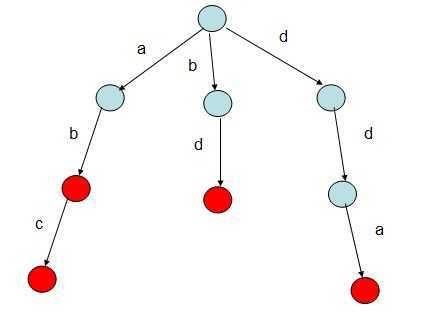标签:style blog http color os io for ar
Trie树也称字典树,因为其效率很高,所以在在字符串查找、前缀匹配等中应用很广泛,其高效率是以空间为代价的。
一.Trie树的原理
利用串构建一个字典树,这个字典树保存了串的公共前缀信息,因此可以降低查询操作的复杂度。
下面以英文单词构建的字典树为例,这棵Trie树中每个结点包括26个孩子结点,因为总共有26个英文字母(假设单词都是小写字母组成)。
则可声明包含Trie树的结点信息的结构体:
#define MAX 26
typedef struct TrieNode //Trie结点声明
{
bool isStr; //标记该结点处是否构成单词
struct TrieNode *next[MAX]; //儿子分支
}Trie;
其中next是一个指针数组,存放着指向各个孩子结点的指针。
如给出字符串"abc","ab","bd","dda",根据该字符串序列构建一棵Trie树。则构建的树如下:

Trie树的根结点不包含任何信息,第一个字符串为"abc",第一个字母为‘a‘,因此根结点中数组next下标为‘a‘-97的值不为 NULL,其他同理,构建的Trie树如图所示,红色结点表示在该处可以构成一个单词。很显然,如果要查找单词"abc"是否存在,查找长度则为 O(len),len为要查找的字符串的长度。而若采用一般的逐个匹配查找,则查找长度为O(len*n),n为字符串的个数。显然基于Trie树的查找 效率要高很多。
但是却是以空间为代价的,比如图中每个结点所占的空间都为(26*4+1)Byte=105Byte,那么这棵Trie树所占的空间则为105*8Byte=840Byte,而普通的逐个查找所占空间只需(3+2+2+3)Byte=10Byte。
二.Trie树的操作
在Trie树中主要有3个操作,插入、查找和删除。一般情况下Trie树中很少存在删除单独某个结点的情况,因此只考虑删除整棵树。
1.插入
假设存在字符串str,Trie树的根结点为root。i=0,p=root。
1)取str[i],判断p->next[str[i]-97]是否为空,若为空,则建立结点temp,并将p->next[str[i]-97]指向temp,然后p指向temp;
若不为空,则p=p->next[str[i]-97];
2)i++,继续取str[i],循环1)中的操作,直到遇到结束符‘\0‘,此时将当前结点p中的isStr置为true。
2.查找
假设要查找的字符串为str,Trie树的根结点为root,i=0,p=root
1)取str[i],判断判断p->next[str[i]-97]是否为空,若为空,则返回false;若不为空,则p=p->next[str[i]-97],继续取字符。
2)重复1)中的操作直到遇到结束符‘\0‘,若当前结点p不为空并且isStr为true,则返回true,否则返回false。
3.删除
删除可以以递归的形式进行删除。
测试程序:
/*Trie树(字典树) 2011.10.10*/#include <iostream>#include<cstdlib>#define MAX 26using namespace std;typedef struct TrieNode //Trie结点声明 { bool isStr; //标记该结点处是否构成单词 struct TrieNode *next[MAX]; //儿子分支 }Trie;void insert(Trie *root,const char *s) //将单词s插入到字典树中 { if(root==NULL||*s==‘\0‘) return; int i; Trie *p=root; while(*s!=‘\0‘) { if(p->next[*s-‘a‘]==NULL) //如果不存在,则建立结点 { Trie *temp=(Trie *)malloc(sizeof(Trie)); for(i=0;i<MAX;i++) { temp->next[i]=NULL; } temp->isStr=false; p->next[*s-‘a‘]=temp; p=p->next[*s-‘a‘]; } else { p=p->next[*s-‘a‘]; } s++; } p->isStr=true; //单词结束的地方标记此处可以构成一个单词 }int search(Trie *root,const char *s) //查找某个单词是否已经存在 { Trie *p=root; while(p!=NULL&&*s!=‘\0‘) { p=p->next[*s-‘a‘]; s++; } return (p!=NULL&&p->isStr==true); //在单词结束处的标记为true时,单词才存在 }void del(Trie *root) //释放整个字典树占的堆区空间 { int i; for(i=0;i<MAX;i++) { if(root->next[i]!=NULL) { del(root->next[i]); } } free(root);}int main(int argc, char *argv[]){ int i; int n,m; //n为建立Trie树输入的单词数,m为要查找的单词数 char s[100]; Trie *root= (Trie *)malloc(sizeof(Trie)); for(i=0;i<MAX;i++) { root->next[i]=NULL; } root->isStr=false; scanf("%d",&n); getchar(); for(i=0;i<n;i++) //先建立字典树 { scanf("%s",s); insert(root,s); } while(scanf("%d",&m)!=EOF) { for(i=0;i<m;i++) //查找 { scanf("%s",s); if(search(root,s)==1) printf("YES\n"); else printf("NO\n"); } printf("\n"); } del(root); //释放空间很重要 return 0;}标签:style blog http color os io for ar
原文地址:http://www.cnblogs.com/happyday56/p/3928701.html